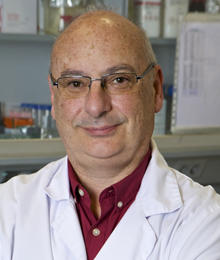An interview with Professor Francisco Juan Martinez Mojica
Professor Francisco Juan Martinez Mojica in the Department of Genetic Physiology and Microbiology at the University of Alicante, Spain. He is well known for his contribution towards research on the CRISPR-Cas gene-editing technique. In this interview he tells us more about how he became interested in microbiology and what his current research focuses on.

Where did your interest in microbiology come from?
I became interested in microbiology when I completed a bachelor's degree course on General Microbiology at the University of Alicante. Thanks to that, I began to understand how fascinating this world of hidden living beings is. I still remember the first time I saw, under a microscope, a population of bacteria moving in every direction, or when colonies appeared on the surface of a plate (whereas a few hours before there was nothing perceptible). Those experiences struck me.
Tell us about your current research.
At present, we are investigating the rules that govern the CRISPR mechanism responsible for providing the carrier bacterium, with a record of encounters with foreign genetic elements.
You have explored micro-organisms belonging to the archaea family. Can you tell us more about this research and how this linked to your discovery of CRISPR?
The initial goal of my doctoral thesis was to unveil the regulatory mechanism that allows extremely halophilic archaea (haloarchaea) to adapt to sudden changes in the salinity of the medium. This led me to sequence regions in the genome of one of these haloarchaea that apparently were involved in salt adaptation. I came across a track of regularly interspaced repeated sequences in one of these regions. Such a peculiar pattern caught my attention.
After ruling out its involvement in adaptation to salinity and noticing its widespread occurrence among prokaryotes, I decided to inquire more about the universal function they might be playing. Ten years after my first encounter with the repeats, we discovered that they flank sequences of foreign origin, serving as records of past infections that could be employed to interfere with invading genetic elements.
Why was this such a revolutionary discovery?
It was known at the time that bacteria and archaea have innate defence resources that protect them from viruses. However, the occurrence in prokaryotes of an adaptive immune system was unique, unexpected and astonishing. In addition to such a valuable progress of knowledge, it opened the opportunity to easily vaccinate a carrier cell against specific viruses, plasmids or any transmissible genetic element. The potential consequences of the discovery, in life and health sciences, were huge.
Tell us more about how you came to name CRISPR?
In 2000, we acknowledged the existence of a widespread family of regularly spaced repeats and called it Short Regularly Spaced Repeats or SRSR. Nevertheless, previously coined acronyms referring to this type of sequences remained in force, particularly DR. Even a new term, SPacers Interspersed Direct Repeats (SPIDR), was recommended later by a research group that had just identified a set of four genes, highly conserved in the vicinity of repeat arrays. In that context, a member of this group requested me to reach an agreement on the name of the repeats from which the associated genes would be baptized. Bearing in mind the features of the SRSR family, I proposed several alternatives, one of which was Clustered Regularly Interspaced Short Palindromic Repeats; or CRISPR, the most comprehensive and eventually, the winning choice.
What is a typical working day for you?
Fortunately, no two working days are alike. Replying to emails is probably the most recurring and time-consuming task, followed by teaching and research duties, as well as the preparation and delivery of all sorts of speeches, which involves me doing a lot of travelling. There is no room for drabness in this job.
Why does microbiology matter?
In addition to the indisputable repercussion of microbes on both life and inert matter of the planet, knowledge emerged from the analysis of micro-organisms, has notably contributed to understanding the biology of all life forms. Moreover, during the last decades, bacteria, archaea, viruses and fungi, have provided extraordinary tools that have led to the emergence of various scientific revolutions. The golden age of biology and biomedicine we are enjoying at present is largely due to microbiology discoveries. Surely, the study of micro-organisms will keep on fuelling progress, endlessly.


